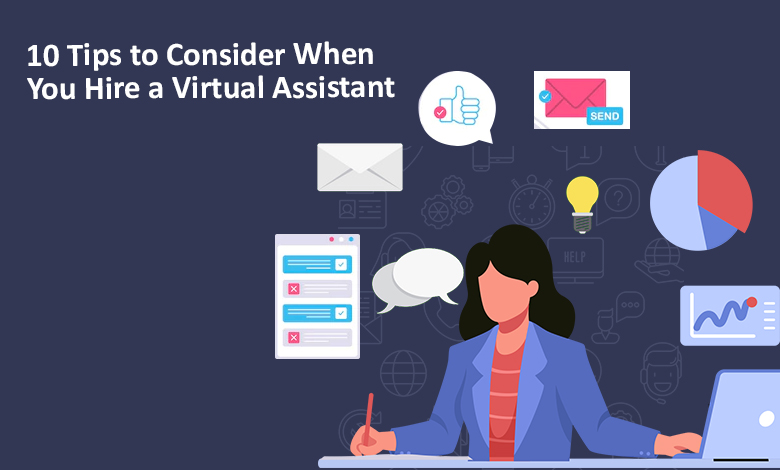10 Tips to Consider When You Hire a Virtual Assistant

The word that we have mostly come across since the pandemic is work from home or remote working. The term, remote employee experience speaks about what an employee goes through while working from their four-wall home setting.
The employee experiences play a significant role in defining the culture of the workplace that further influences decision-making, performance, and retention period in the organization.
There are a lot of things that are different in a remote setting. The employees working from home do not report to the physical office, communication is entirely virtual, and the timings are mostly flexible unlike working in an office environment.
10 Strategies for the best remote experience
There are certain strategies to improve employee experience and create work-life balance. Some of the best remote work practices that you can apply include the following:
-
Work-life balance is prime:
The well-being of working individuals has become the need of the hour. Remote work can be tiring and monotonous at times and requires mental rest. Although employees can avoid commuting to their workplaces, mundane routines can spoil productivity as well. Thus, to create a work-life balance, personal and professional hours need to be separated. Evenly distribution of tasks and following deadlines for both household chores and client assignments can prove to be fruitful.
-
Mental health needs attention:
To meet targets and keep up with the pace of over-times and household tasks, employees give up on their mental health at times. Work isn’t all about the annual turnovers, but how you feed your soul at work too. Employees must participate in mental health programs conducted by the employers to help them deal with insomnia, irritability, and other issues hindering their productivity. Nonetheless, employees deserve a good number of vacation leaves so that they can enjoy their days out when they are not at work.
-
Professional Development:
Employers should indulge in making investments in the professional development of employees that can improve their engagement and performance. Professional training helps employees get a hang of the state-of-the-art technologies along with a consistent learning zeal fueling their competencies.
-
Company culture:
Positive company culture is the key to employee retention even when they are working in a remote setting. Positive workplace culture can make the virtual environment encouraging where employees do not feel like zombies meeting dreadful deadlines. Employees feel valued and respected when they are encouraged and appreciated for what they do and how they do it. Clear business principles provide your staff with a sense of direction and stability and might aid them in making the best choices.
-
Appreciation is essential:
Employee appreciation is an extremely essential element of keeping up the remote employment spirits high. Employers must chat with their employees most often to understand the challenges they face and further find feasible solutions. Also, the employees must be gifted rewards for their hard work and diligence which makes them feel proud and valuable. Noticing individual efforts over teamwork results is always considered the best.
-
Productivity check:
Even though having a good remote working experience might increase productivity, remote workers still require direction, encouragement, and prodding to keep doing their best job. Keep track of and evaluate the time spent by your employees on activities, projects, and clients. Access comprehensive reports to uphold and improve accountability. Keep track of the websites and applications that your remote workforce utilizes during working hours. To keep your remote workers concentrated on the task at hand, deploy distraction warnings.
-
Communication needs clarity:
Examine your channels carefully for a moment. Every kind of communication offers a different user experience. Evaluate your communication channels and keep a record of what is said, how it is communicated, and for what reason. Keep messaging tools like Slack or Google Chat in hand for casual talks as they are excellent choices for daily communication. For a while, stop sending formal emails and start exchanging GIFs, films, and games instead. These can serve as a spark for a lighter, more laid-back workplace. Your staff will take over from there.
-
Creative remote work setting:
Employees must be inspired to create a creative working desk, dress like they would do in workplaces, and keep a plant with a cup of coffee to feel the aura of work even at home. Taking short breaks at intervals and preparing some mindfulness exercises along with a collaborative music playlist works even better to keep the mind sane and heart happier.
-
Encourage socializing:
You should create a social media network so that employees may communicate and organize online get-togethers. You can organize activities to foster camaraderie among your staff every weekend. This might reduce workplace tension after a difficult workweek. As a result, the self-awareness of your employees would likewise increase. Making sure that your employees have time off is crucial to influencing how they see your business.
-
Celebrate employee milestones:
Success ought to be celebrated! No matter how big or small an achievement is, it deserves applause. Birthdays, anniversaries, and completing goals should all be celebrated in person or electronically at work. You may arrange a surprise online meeting on an employee’s birthday to wish them a happy birthday and recognize their contributions to the business. Many businesses frequently ignore this gesture. Celebrating noteworthy accomplishments shows your staff that you value their minor victories and will motivate them to keep improving.
You are in charge of implementing the strategies as you are the expert on your business and know how to optimize it based on the work culture you have.
Keep in mind that your staff is unlikely to want to be micromanaged every time, and love to generate quality outcomes when you show trust. Put your efforts into developing a strong feedback culture and chain of collaboration. At the end of the day, everyone will applaud the outcomes. Hire a virtual employee and experience how actual remote work feels like even if you are in a different time zone.


